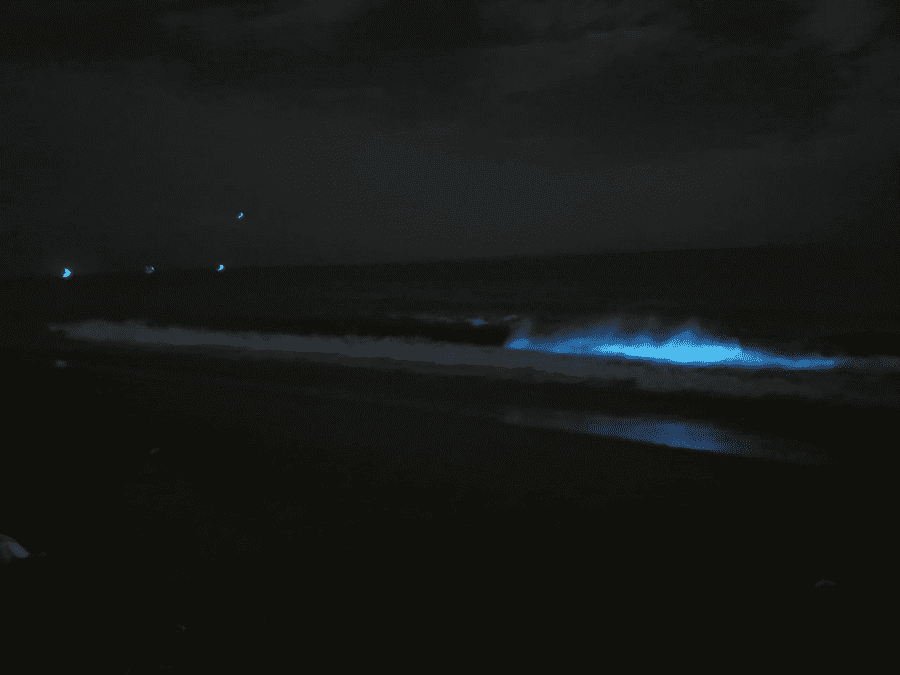
Intriguing blue hue off Chennai coast spells trouble

Residents of Chennai’s Valmiki Nagar in the last couple of days have chanced upon a spectacular sight on the Bay of Bengal. Many stood transfixed seeing thousands of tiny star-like bioluminescent phytoplanktons scintillating like a starry sky off the Chennai shore.
“It was like a floating tube light which appeared briefly. We were awe struck by its beauty. Truly, nature is humbling,” said Navin Ram, a resident of Valmiki Nagar who had taken his kids on Sunday evening to observe this rare sight.
Certain creatures on land and sea, like planktons, can produce light caused by chemical reactions taking place within their bodies, a phenomenon known as bioluminescence.

Bioluminescence results from a chemical reaction that produces this light and this is also called chemi-luminescence. Certain types of chemicals when mixed together produce energy which ‘excites’ other particles on vibration and generate light which causes the glow.
The group of chemicals involved to make planktons glow are classified as luciferins and the light is produced by a series of oxidation reactions set off by a catalyst called luciferase.
“Bioluminescence is considered one of the most beautiful biological phenomena. The commonest occurrences that we see on the coasts of Arabian Sea and Indian Ocean are from luminescent phytoplanktons. However, this property is owned by a wide range of marine taxa, from bacteria to vertebrates, underlining that it is a trait that has been there for a long time over the course of evolution. Blue is the most common colour emitted by these organisms, and blue light receptors were the first receptors to originate in deep marine life,” says Yadukrishnan, a researcher in biological sciences at ISER Bhopal.
“Even though there are multiple hypotheses on the evolutionary origins of these organisms, there has been limitations on conducting experimental studies. Advancements in genomic and bioinformatic tools are helping us now to push the barriers and look better into their origins, and their importance in deep water adaptations. In addition, exploring them might provide invaluable tools in scientific studies – like how the use of Green Fluorescent Proteins (GFP) isolated from bioluminescent jellyfish had revolutionized molecular and cell biology research,” Yadukrishnan adds.
Social media was abuzz with people discussing the beauty of this phenomenon but there is far more to it than that. The Noctiluca algae which is also referred to as sea tinkle, is a parasite that occurs in patches or ‘blooms’ in the Northern Arabian Sea.
Science magazine Nature in 2014 published a research paper according to which the massive outbreaks of Noctiluca scintillans blooms in the Arabian Sea was due to spread of hypoxia.
This means that these fluorescent blue patches are an indication of a decline of oxygen in the marine ecosystem. In the short run they compete with local fish for food. Noctiluca acts as a predator of a very important plankton at the base of the fish-food chain, namely diatoms, and also excretes large amounts of ammonia, which is linked with massive aquatic deaths.

The rare phenomena observed in the Bay of Bengal in the past was attributed to factors such as ocean pollution. However recently there has been a consensus attributing this to the warming of oceans.
A warming ocean means there is a variation of temperature difference between each layer of the sea water and this temperature gradation might cause redistribution of ocean nutrients in the marine food system, causing irreversible damage to the fragile marine system of the Bay of Bengal.
There is an urgent need to further investigate this phenomenon using remote sensing tools. If indeed these are harmful algae blooms, corrective action must be taken as soon as possible.

